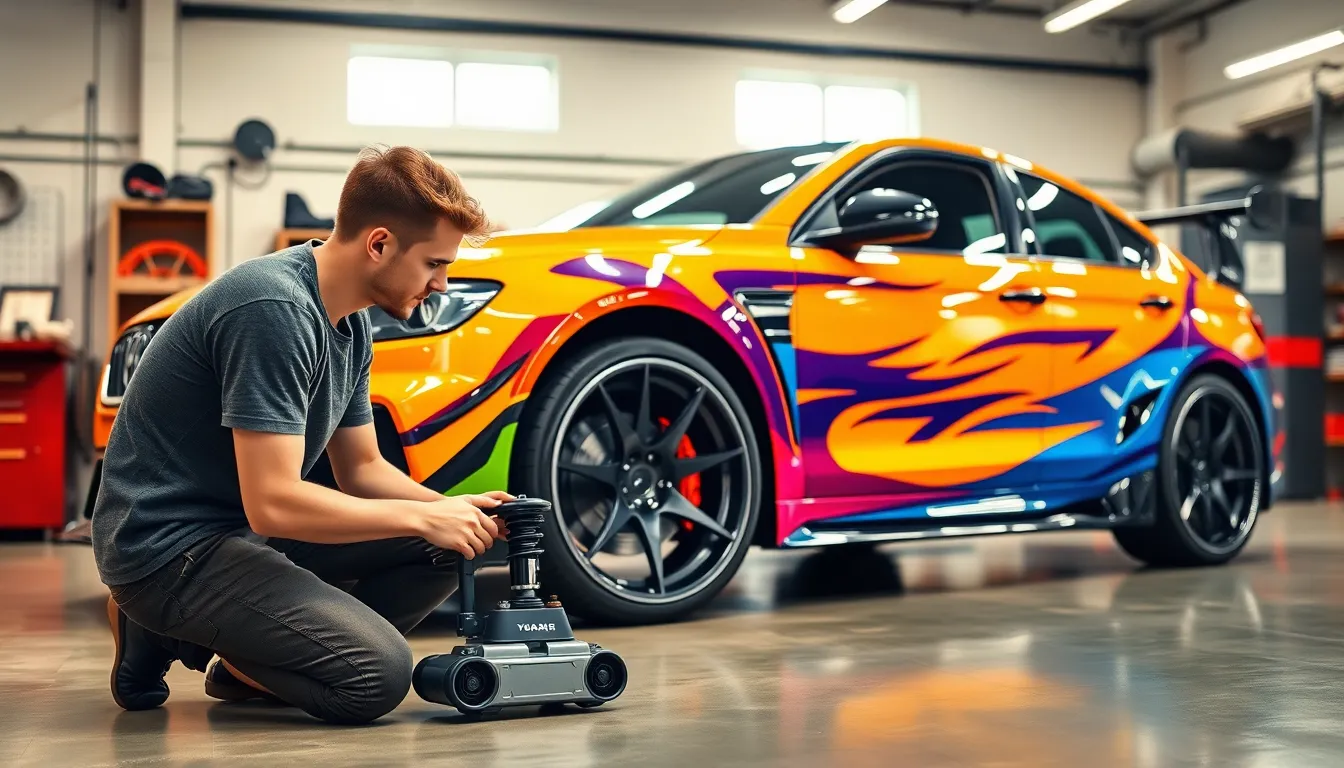We’ve all felt that rush when a perfectly tuned car roars past us on the street – that unmistakable sound of precision engineering meeting passionate craftsmanship. Tuned cars represent far more than simple transportation; they’re rolling masterpieces that showcase the art of automotive modification and performance enhancement.
The industry of car tuning has exploded into a multi-billion dollar industry that attracts everyone from weekend warriors to professional racers. Whether you’re dreaming of boosting your daily driver’s horsepower or completely transforming your vehicle’s aesthetics, understanding the fundamentals of tuning opens up endless possibilities for customization.
From ECU remapping and turbo upgrades to suspension modifications and body kits, we’re diving deep into everything you need to know about creating your perfect ride. Let’s explore how tuned cars are reshaping automotive culture and discover why millions of enthusiasts worldwide are choosing modification over stock.
What Are Tuned Cars and Why They’re Taking Over the Streets
Tuned cars represent vehicles that have been modified beyond their factory specifications to enhance performance, aesthetics, or both. We’re witnessing a transformation where everyday drivers push the boundaries of what their machines can achieve through careful modifications and upgrades.
Performance tuning forms the core of most automotive modifications, involving changes to the engine, exhaust system, suspension, and electronic control units. Drivers commonly pursue increased horsepower, improved handling characteristics, and enhanced acceleration through these strategic upgrades.
Aesthetic modifications complement performance enhancements, allowing car owners to express their personal style through custom paint jobs, body kits, lighting systems, and interior upgrades. We see enthusiasts creating unique visual identities that reflect their personalities and preferences.
The accessibility of tuning has dramatically increased due to technological advances and the availability of aftermarket parts. Modern diagnostic tools, performance chips, and bolt-on modifications make it easier than ever for car owners to modify their vehicles without extensive mechanical knowledge.
Social media platforms have amplified the tuning culture by providing spaces for enthusiasts to showcase their builds, share modification tips, and connect with like-minded individuals. We observe viral content featuring impressive transformations that inspire others to begin their own tuning journeys.
Economic factors contribute to the popularity of tuning, as modifying an existing vehicle often costs less than purchasing a high-performance car from the factory. Enthusiasts can gradually upgrade their vehicles over time, spreading costs across months or years while achieving their desired performance goals.
Street racing culture and automotive entertainment have mainstreamed tuned cars through movies, video games, and racing events. We notice increased public interest following popular media portrayals of modified vehicles and underground racing scenes.
The aftermarket industry has responded to growing demand by developing innovative products, creating a cycle where better parts lead to more impressive builds. Manufacturers now produce everything from complete engine swap kits to advanced aerodynamic components designed specifically for tuning applications.
Performance Modifications That Transform Your Ride

Engine modifications form the foundation of any serious tuning project. We’ll explore the most impactful upgrades that unlock your vehicle’s hidden potential.
Engine Tuning and ECU Remapping
ECU remapping stands as the most cost effective modification for instant power gains. Modern engines operate with conservative factory settings that prioritize reliability and emissions compliance over maximum performance. Professional tuning unlocks 15-30% more horsepower and torque by optimizing fuel maps, ignition timing, and boost pressure on turbocharged engines.
Cold air intake systems complement ECU tuning by delivering denser air to the combustion chamber. These modifications typically add 5-15 horsepower while improving throttle response and engine sound. High flow air filters like K&N or AEM brands reduce restriction while maintaining filtration efficiency.
Fuel system upgrades become necessary when pushing beyond 20% power increases. Larger fuel injectors, high pressure fuel pumps, and upgraded fuel rails ensure adequate delivery under demanding conditions. Ethanol blends like E85 support aggressive tuning strategies while providing cooling benefits that prevent detonation.
Turbocharger and Supercharger Upgrades
Turbocharger upgrades deliver the most dramatic power increases for forced induction engines. Larger turbos like Garrett GT series or Precision units can double factory horsepower numbers when paired with proper supporting modifications. Ball bearing turbos reduce lag while improving durability compared to journal bearing designs.
Intercooler systems maximize the effectiveness of turbocharger modifications. Front mount intercoolers reduce intake temperatures by 50-100 degrees Fahrenheit compared to stock systems. Brands like Mishimoto and CX Racing offer direct bolt on answers that maintain street drivability.
Supercharger kits provide linear power delivery without turbo lag concerns. Centrifugal superchargers from Vortech or Paxton deliver smooth power curves that feel naturally aspirated. Positive displacement blowers like Eaton TVS units generate instant torque from idle speeds.
Exhaust System Enhancements
Cat back exhaust systems optimize flow while creating distinctive sound signatures. Performance exhausts from Borla, Magnaflow, or Akrapovic reduce backpressure by 20-40% compared to restrictive factory systems. Stainless steel construction ensures longevity while mandrel bent piping maintains consistent diameter throughout bends.
Downpipe upgrades unlock important power on turbocharged applications. High flow catalytic converters or catless designs eliminate the primary restriction point in most factory exhaust systems. These modifications typically yield 15-25 horsepower gains when combined with ECU tuning.
Headers and manifolds address naturally aspirated engines’ exhaust flow limitations. Long tube headers increase torque production across the entire RPM range while short tube designs focus on high RPM power. Ceramic coatings reduce under hood temperatures while improving heat rejection efficiency.
Aesthetic Modifications That Make Tuned Cars Stand Out
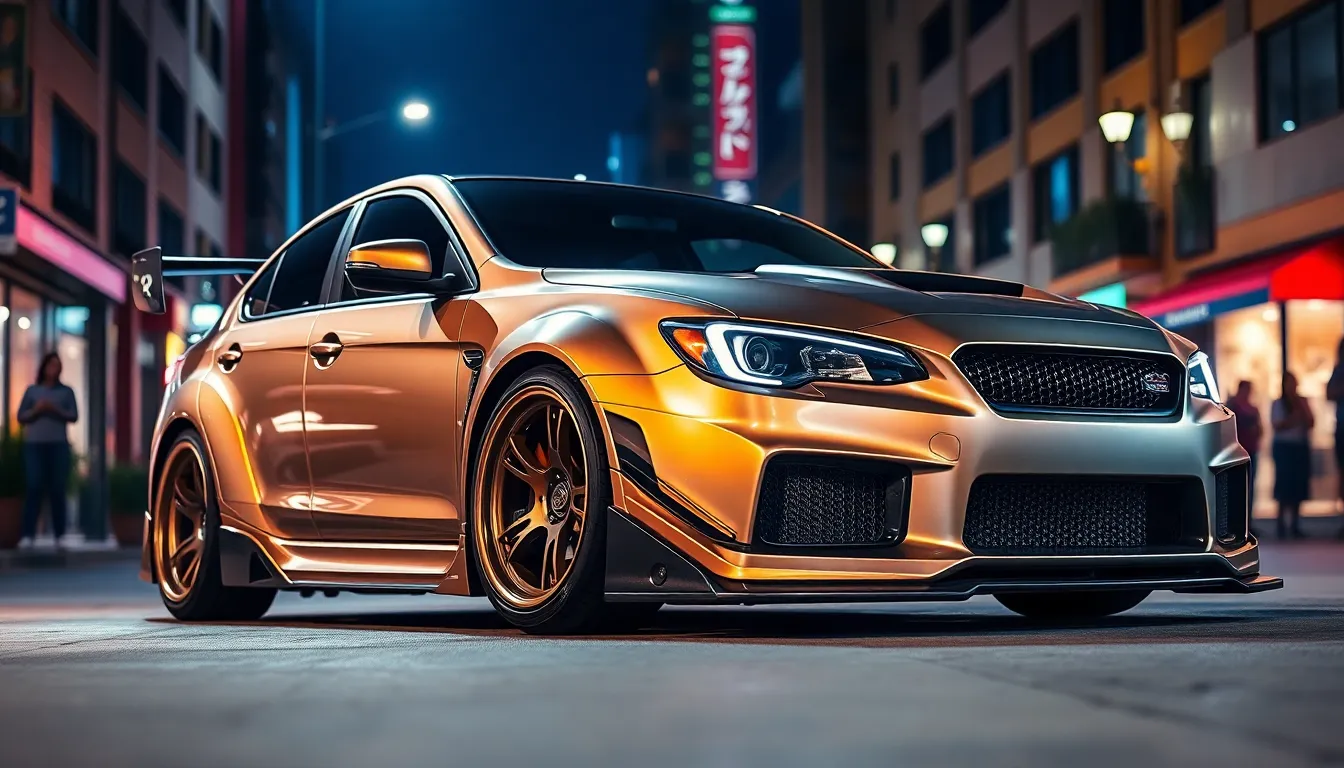
While performance upgrades deliver the power, aesthetic modifications create the visual impact that turns heads on every street corner. These exterior enhancements transform ordinary vehicles into stunning automotive statements that reflect personal style and showcase modification expertise.
Body Kits and Aerodynamic Components
Body kits serve as the foundation for dramatic visual transformations that completely alter a vehicle’s appearance. We typically see three main categories: front bumpers, side skirts, and rear bumpers that work together to create cohesive designs. Popular manufacturers like Rocket Bunny, Liberty Walk, and Prior Design offer widebody kits that add aggressive fender flares and extended side panels.
Front splitters and canards direct airflow around the vehicle while creating race inspired aesthetics that suggest serious performance capabilities. These carbon fiber components attach to factory bumpers or aftermarket replacements to enhance downforce at highway speeds. Side skirts connect the front and rear visual elements while reducing air turbulence beneath the chassis.
Rear spoilers and wings provide the finishing touch that balances the overall design package. Fixed wings from brands like APR Performance and Voltex deliver actual aerodynamic benefits at track speeds exceeding 80 mph. Duck tail spoilers offer subtler enhancement for daily driven builds that prioritize street friendly proportions.
Diffusers integrate into rear bumper designs to manage airflow exiting from underneath the vehicle. These honeycomb or blade style components create visual depth while serving functional purposes during spirited driving sessions.
Custom Paint Jobs and Vinyl Wraps
Custom paint applications allow unlimited creative expression that transforms any vehicle into a unique automotive canvas. We observe everything from subtle color changes to elaborate airbrushed masterpieces featuring complex graphics and metallic effects. Professional paint shops can achieve mirror like finishes using multiple clear coat layers and wet sanding techniques.
Vinyl wraps provide reversible alternatives that protect original paint while offering bold visual statements. 3M and Avery Dennison manufacture premium wrap materials in hundreds of colors including matte, gloss, satin, and textured finishes. Carbon fiber patterns, chrome effects, and color shifting films create eye catching appearances without permanent modifications.
Partial wraps focus attention on exact vehicle sections like hoods, roofs, or accent stripes that complement existing paint schemes. Racing liveries inspired by professional motorsports teams bring authentic competition aesthetics to street builds. Custom graphics incorporating personal logos, sponsors, or artistic designs showcase individual creativity and build themes.
Chrome delete treatments using black or body colored vinyl eliminate factory chrome trim for cleaner modern appearances. Window tinting complements wrap colors while providing privacy and UV protection for interior components.
Wheel and Tire Upgrades
Wheels dramatically influence overall vehicle stance and proportions more than any other single modification. We recommend lightweight forged wheels from manufacturers like HRE, Volk Racing, and BBS that reduce unsprung weight while delivering stunning visual impact. Popular styles include deep dish designs, split spoke configurations, and modern mesh patterns.
Sizing considerations balance aesthetics with performance as larger diameter wheels accommodate bigger brake systems but may compromise ride quality. Common upgrades range from 18 to 22 inches depending on vehicle type and intended use. Wheel widths between 9 and 12 inches create aggressive fitments that fill wheel wells completely.
Tire selection affects both appearance and driving characteristics through sidewall profiles and tread patterns. Low profile performance tires from Michelin, Continental, and Toyo provide responsive handling with minimal sidewall flex. Stretched tire installations create unique visual effects where narrow tires mount on wide wheels.
Wheel finishes including brushed, polished, powder coated, and anodized options allow precise color matching with vehicle themes. Two piece and three piece constructions offer custom sizing combinations that achieve perfect fitments for any application.
Popular Tuned Car Models That Dominate the Scene
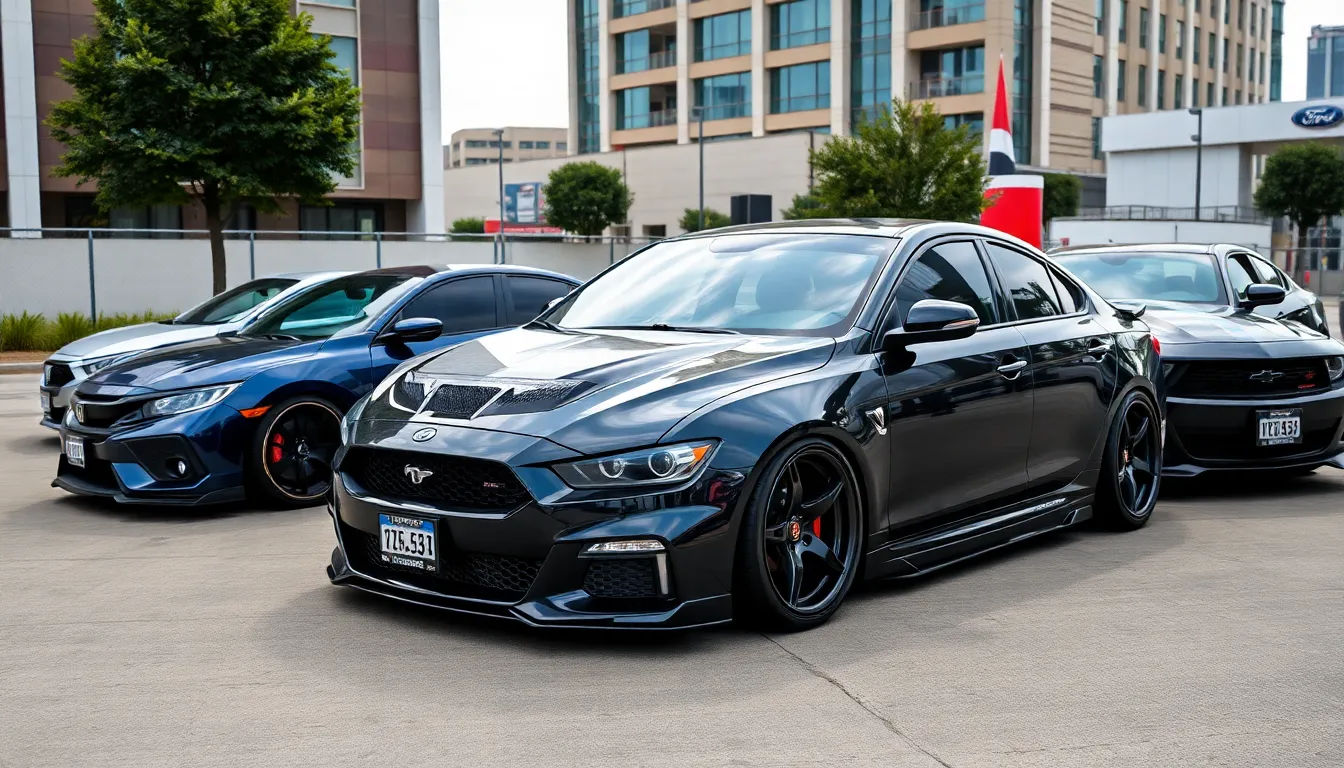
The tuning community has gravitated toward certain vehicles that offer the perfect blend of performance potential and modification accessibility. These platforms have proven themselves as the foundation for countless impressive builds worldwide.
Japanese Icons: Honda Civic Type R and Subaru WRX STI
Honda Civic Type R stands as the ultimate hot hatch platform, delivering factory turbocharged power that responds exceptionally well to ECU tuning modifications. Stock examples produce 306 horsepower from their 2.0-liter turbocharged K20C1 engine, but we’ve seen tuned versions push beyond 400 horsepower with simple bolt-on modifications. Aftermarket companies like Hondata and KTuner offer comprehensive ECU answers that unlock important power gains through optimized fuel maps and boost levels.
Subaru WRX STI remains the all-wheel-drive tuning champion, featuring the legendary EJ257 boxer engine that’s built for modification from the factory. These vehicles excel at handling turbocharger upgrades, with popular options including Garrett GTX2867R and Precision 5858 turbos that can produce over 500 horsepower. Companies like COBB Tuning and AccessPORT provide complete tuning packages specifically designed for Subaru’s unique boxer engine architecture.
European Powerhouses: BMW M3 and Volkswagen Golf GTI
BMW M3 represents German engineering excellence in the tuning industry, with each generation offering distinct modification potential. Current F80 M3 models feature twin-turbocharged S55 engines that respond brilliantly to software tuning, typically gaining 50-80 horsepower through ECU remapping alone. Brands like Dinan and ESS Tuning specialize in BMW performance upgrades, offering everything from intake systems to complete supercharger kits.
Volkswagen Golf GTI has earned its reputation as the accessible performance car, featuring the versatile EA888 turbocharged engine across multiple generations. These vehicles excel at Stage 1 tuning modifications, where simple software changes and downpipe upgrades can increase power from 228 horsepower to over 300 horsepower. APR and Unitronic lead the VW tuning market with proven software answers and comprehensive hardware packages.
American Muscle: Ford Mustang GT and Chevrolet Camaro SS
Ford Mustang GT dominates the American muscle tuning scene with its naturally aspirated Coyote V8 engine that loves forced induction additions. Stock 5.0-liter engines produce 460 horsepower, but supercharger kits from Roush and Whipple can push output beyond 700 horsepower while maintaining daily drivability. These vehicles also benefit from extensive suspension modification options, with companies like Ford Performance offering complete handling packages.
Chevrolet Camaro SS brings GM’s LS and LT engine legacy to modern tuning enthusiasts, featuring the LT1 V8 that responds exceptionally well to both naturally aspirated and forced induction modifications. Tuning companies like Texas Speed and Performance offer complete camshaft packages that can increase naturally aspirated power to over 500 horsepower. Supercharger options from Magnuson and ProCharger can push these engines beyond 650 horsepower with supporting modifications.
Essential Tuning Parts Every Enthusiast Should Know

Building on the foundation of engine and aesthetic modifications we’ve explored, certain components form the backbone of any serious tuning project. We’ve identified the core parts that deliver maximum impact for your tuning investment.
Performance Air Intakes and Filters
Cold air intake systems represent the most accessible entry point for enthusiasts beginning their tuning journey. We recommend starting with brands like K&N, AEM, and Injen that offer complete intake kits for most popular platforms. These systems replace restrictive factory airboxes with free-flowing designs that draw cooler air from outside the engine bay.
High-flow air filters provide immediate benefits without requiring extensive modifications to your vehicle. Drop-in replacements from companies like aFe Power and BMC can increase airflow by 15-20% while maintaining proper filtration. Oiled cotton filters typically outperform dry synthetic options in terms of flow rates.
Short ram intakes offer a budget-friendly alternative for drivers seeking moderate performance gains. These systems position the filter closer to the engine but still improve upon factory restrictions. We’ve seen power increases of 5-10 horsepower on naturally aspirated engines with quality short ram setups.
Coilover Suspension Systems
Adjustable coilover systems transform your vehicle’s handling characteristics more dramatically than any other single modification. Brands like BC Racing, Fortune Auto, and KW Suspensions offer height and damping adjustability that allows fine-tuning for different driving conditions. Professional-grade coilovers feature 32-way damping adjustment and pillow ball mounts.
Monotube shock construction delivers superior performance compared to twin-tube designs found in factory suspensions. We prefer monotube coilovers because they provide better heat dissipation and more consistent damping under aggressive driving conditions. Companies like Öhlins and Bilstein specialize in monotube technology.
Spring rates require careful consideration based on your vehicle’s weight distribution and intended use. Street-focused setups typically use spring rates 20-40% stiffer than stock, while track applications may require rates 50-100% higher. We always recommend consulting with suspension specialists to determine optimal spring rates for your exact platform.
High-Performance Brake Kits
Big brake kits provide the stopping power necessary to match increased engine performance safely. Systems from Brembo, StopTech, and AP Racing feature larger rotors and multi-piston calipers that resist fade under repeated hard braking. Track-focused drivers often upgrade to 6-piston front calipers with 14-inch rotors.
Two-piece floating rotors offer important advantages over factory single-piece designs through reduced unsprung weight and better heat management. These rotors feature separate aluminum hats bolted to iron rings, allowing thermal expansion without warping. We’ve measured temperature reductions of 50-100 degrees Fahrenheit with quality two-piece rotors.
Performance brake pads complete the stopping equation by providing higher friction coefficients and fade resistance. Compounds like Hawk Performance HP+ and Ferodo DS2500 work effectively on both street and track applications. Racing pads such as Pagid RS29 require warm-up but deliver exceptional performance under extreme conditions.
Top Tuning Shops and Professionals to Trust With Your Build
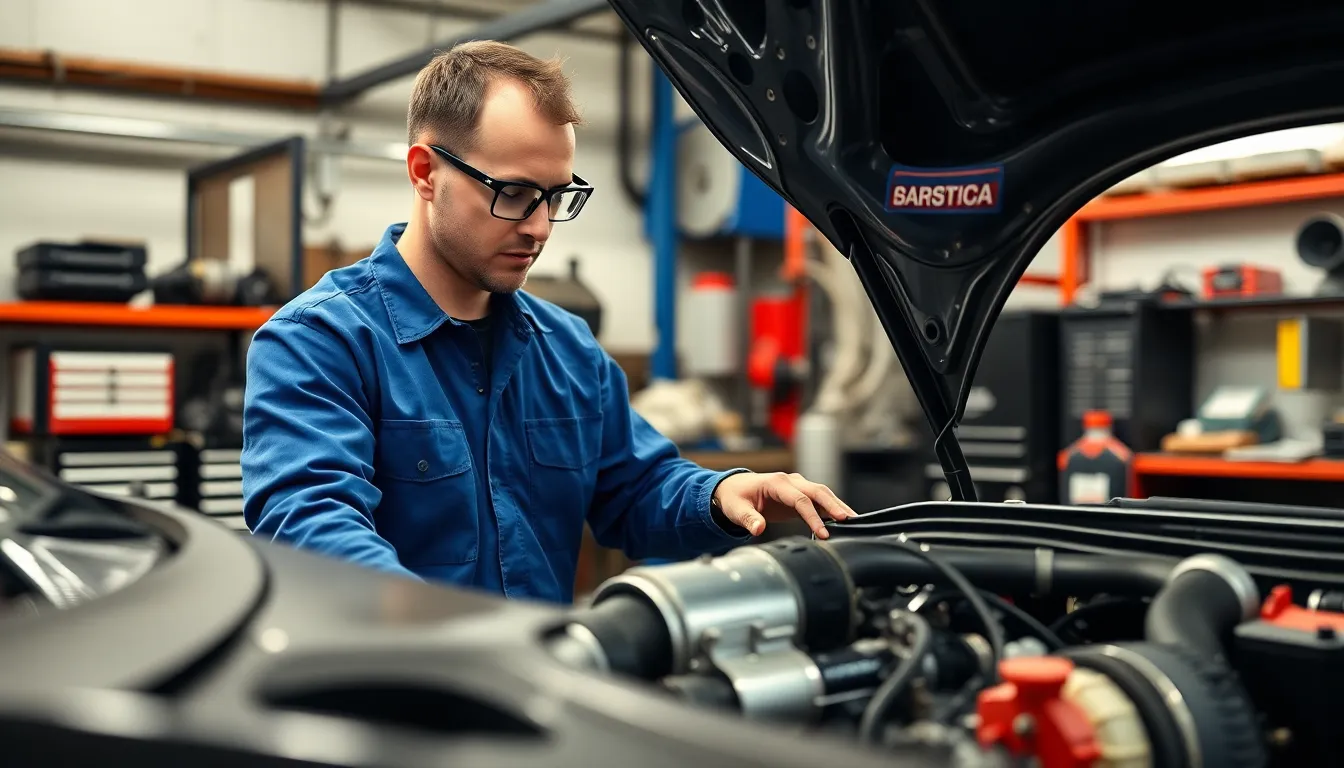
We’ve covered the essential modifications and parts that transform ordinary vehicles into high-performance machines, but choosing the right professionals to execute your vision makes all the difference between a successful build and a costly mistake. Finding reputable tuning shops requires careful research and consideration of several critical factors that directly impact your project’s outcome.
Research and reputation should guide your initial selection process. Online reviews from multiple platforms like Google, Yelp, and automotive forums provide valuable insights into customer experiences and shop reliability. Social media presence often showcases completed builds and demonstrates the quality of work you can expect from potential tuning partners.
Specialization in your exact vehicle platform ensures expertise and familiarity. Shops that focus on particular makes like Honda, BMW, or Ford typically possess deeper knowledge of common issues, optimal modification paths, and parts compatibility. Platform specialists often maintain relationships with manufacturers and can source hard to find components more efficiently than generalist shops.
Certification and professional credentials validate technical competency. ASE certifications, manufacturer training programs, and dyno tuning credentials demonstrate commitment to professional development. Shops with certified technicians typically follow industry best practices and maintain higher standards throughout the modification process.
Portfolio and previous builds reveal the shop’s capabilities and style. Request to see examples of completed projects similar to your goals, paying attention to quality of fabrication work, attention to detail, and overall execution. High quality shops proudly display their work and provide references from satisfied customers.
Equipment and facilities directly impact the quality of your build. Modern diagnostic equipment, professional grade lifts, proper ventilation systems, and climate controlled environments indicate serious investment in quality work. Dyno facilities on site or partnerships with reputable dyno shops enable proper tuning and power verification.
Communication and project management separate professional shops from amateur operations. Quality tuning shops provide detailed estimates, regular progress updates, and clear timelines for completion. They discuss potential complications upfront and maintain transparent pricing throughout the modification process.
Warranty and support policies protect your investment long term. Reputable shops stand behind their work with comprehensive warranties on labor and often extend parts warranties beyond manufacturer coverage. Post completion support for troubleshooting and adjustments demonstrates confidence in their craftsmanship.
Pricing structure should reflect the complexity and quality of work performed. While cost shouldn’t be the only factor, extremely low prices often indicate corner cutting or inexperienced technicians. Quality tuning work requires important time investment and specialized knowledge that commands fair compensation.
Legal Considerations for Modified Vehicles
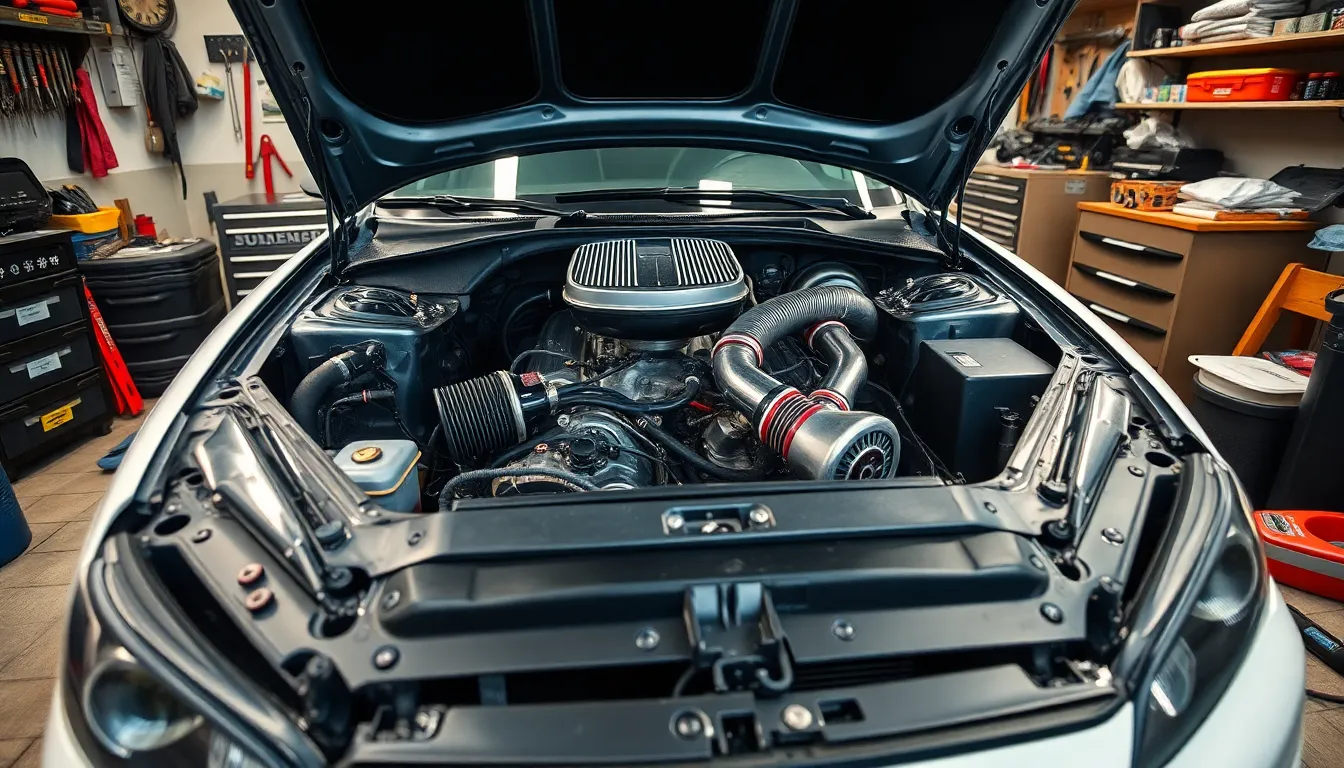
Handling the legal industry of vehicle modifications requires careful attention to federal and state regulations that govern tuned cars. We’ve compiled essential information to help enthusiasts stay compliant while pursuing their tuning goals.
Emissions Compliance and State Regulations
Federal emissions standards apply to all modified vehicles under the Clean Air Act, making it illegal to remove or disable emissions control equipment on street-driven cars. We must understand that the EPA requires all vehicles to maintain their original emissions certification regardless of performance modifications.
California Air Resources Board (CARB) compliance sets the strictest standards nationwide, with Executive Orders (EO) required for aftermarket parts to be street legal. States like New York, Connecticut, and Massachusetts have adopted California’s emissions standards, affecting millions of tuned car owners across these regions.
50-state legal parts carry both EPA and CARB certifications, ensuring nationwide compliance for popular modifications like cold air intakes and exhaust systems. Brands such as AEM, K&N, and Borla manufacture components specifically designed to meet these stringent requirements.
Annual inspection requirements vary significantly by state, with some requiring emissions testing while others focus solely on safety equipment. We recommend checking your state’s exact regulations before beginning any modification project, as violations can result in failed inspections and costly reversal of modifications.
Exemptions for race-only vehicles exist in most states, allowing unrestricted modifications for cars used exclusively on closed courses. But, these exemptions typically require removing license plates and street registration, limiting the vehicle’s use to track events only.
Insurance Implications for Tuned Cars
Coverage modifications become necessary when vehicle values increase substantially through performance and aesthetic upgrades. We advise documenting all modifications with receipts, photos, and professional appraisals to ensure adequate coverage limits.
Declared modifications must be reported to insurance companies to maintain policy validity, as undisclosed changes can void coverage entirely. Major insurers like State Farm, Allstate, and Progressive offer specialized modified vehicle policies that account for aftermarket parts and increased values.
Premium increases typically range from 15% to 40% depending on modification types, with engine performance upgrades generating higher rate adjustments than aesthetic changes. Comprehensive coverage becomes crucial for protecting expensive aftermarket components like turbo systems, custom wheels, and body kits.
Specialty insurers such as Hagerty, Grundy, and American Modern focus specifically on modified and collector vehicles, often providing better coverage options than traditional carriers. These companies understand the tuning community and offer agreed-value policies that guarantee full compensation for total losses.
Track day exclusions appear in most standard policies, requiring separate motorsports insurance for vehicles used in racing or high-performance driving events. We recommend purchasing event-exact coverage through companies like Lockton Motorsports or RLI Insurance when participating in track activities.
Budget-Friendly Tuning Options for Beginners
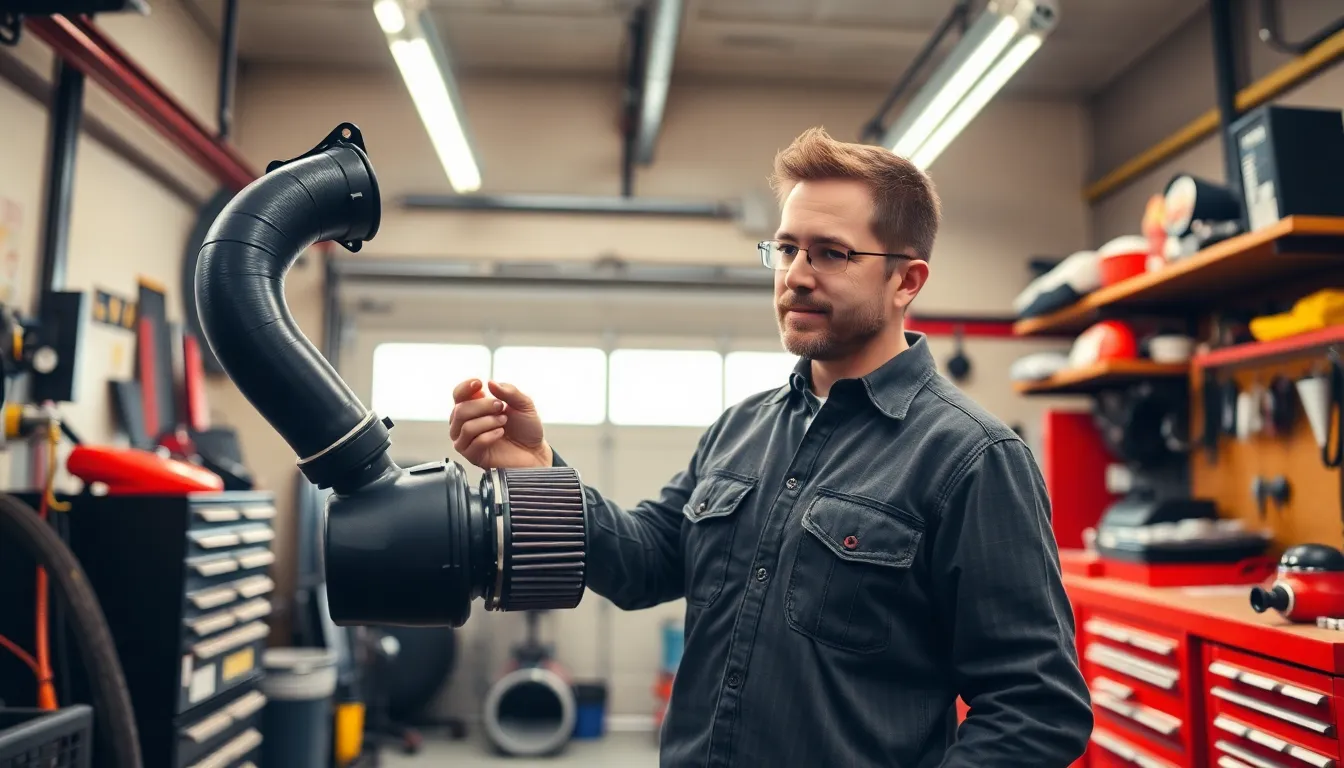
Starting your tuning journey doesn’t require emptying your bank account or diving into complex modifications. We’ve compiled the most accessible entry points that deliver noticeable improvements without breaking the budget or overwhelming newcomers to the scene.
Cold Air Intake Systems represent the most affordable performance modification for beginners. These systems typically cost between $150-$400 and can increase horsepower by 5-15 HP while improving throttle response. K&N and AEM offer beginner-friendly options that require only basic hand tools and 30-60 minutes for installation. Most importantly, these modifications maintain emissions compliance and don’t void warranties when properly installed.
Performance Air Filters provide an even more budget-conscious starting point at $30-$80. Drop-in performance filters from brands like K&N, AFE, and Injen replace restrictive factory filters without modifying the intake system. These filters improve airflow by 10-15% and last significantly longer than paper filters, making them cost-effective long-term investments.
ECU Tuning Software offers tremendous value for money-conscious enthusiasts. Handheld tuners like the Bama Performance or SCT X4 cost $300-$500 and can unlock 15-30 horsepower gains through optimized fuel maps and timing adjustments. These devices plug directly into your vehicle’s diagnostic port and require no mechanical installation, making them perfect for nervous beginners.
Lowering Springs transform your vehicle’s appearance and handling for $200-$500. Eibach Pro-Kit and H&R Sport springs lower ride height by 1-2 inches while maintaining ride quality and safety. These modifications require professional installation but offer dramatic visual impact and improved cornering performance without the complexity of full coilover systems.
Cat-Back Exhaust Systems deliver both performance and sound improvements for $400-$800. Companies like Flowmaster, Borla, and MBRP manufacture bolt-on systems that increase horsepower by 8-15 HP while providing aggressive exhaust notes. Most systems include detailed instructions and can be installed with basic tools in 2-3 hours.
Performance Spark Plugs and Ignition Coils represent maintenance upgrades that enhance performance. NGK Iridium IX plugs cost $8-15 each and improve combustion efficiency, while performance ignition coils from brands like Accel or MSD range from $40-$100 per coil. These components are particularly beneficial for older vehicles with worn ignition systems.
Sway Bars and Chassis Bracing improve handling characteristics without major suspension overhauls. Rear sway bars cost $150-$300 and dramatically reduce body roll during cornering, while strut tower braces range from $100-$250 and increase chassis rigidity. Both modifications bolt directly to existing mounting points and require minimal mechanical experience.
Aesthetic Modifications allow personalization without performance complexity. Vinyl wraps cost $500-$2000 depending on coverage area and complexity, while window tinting ranges from $200-$600 for full vehicle treatment. Custom emblems, badges, and interior accessories provide additional personalization opportunities for under $200.
Basic Maintenance Upgrades should precede any performance modifications. High-performance motor oils like Mobil 1 or Royal Purple cost $40-$60 per change and protect modified engines better than conventional oils. Performance brake pads from EBC or Hawk cost $80-$150 per axle and improve stopping power while reducing brake fade during spirited driving.
Used Parts Markets offer important savings for budget-conscious builders. Facebook Marketplace, eBay Motors, and enthusiast forums frequently feature quality used parts at 40-60% off retail prices. We recommend focusing on non-wear items like intake manifolds, throttle bodies, and suspension components when shopping used markets to maximize value while maintaining reliability.
Advanced Tuning Techniques for Serious Enthusiasts
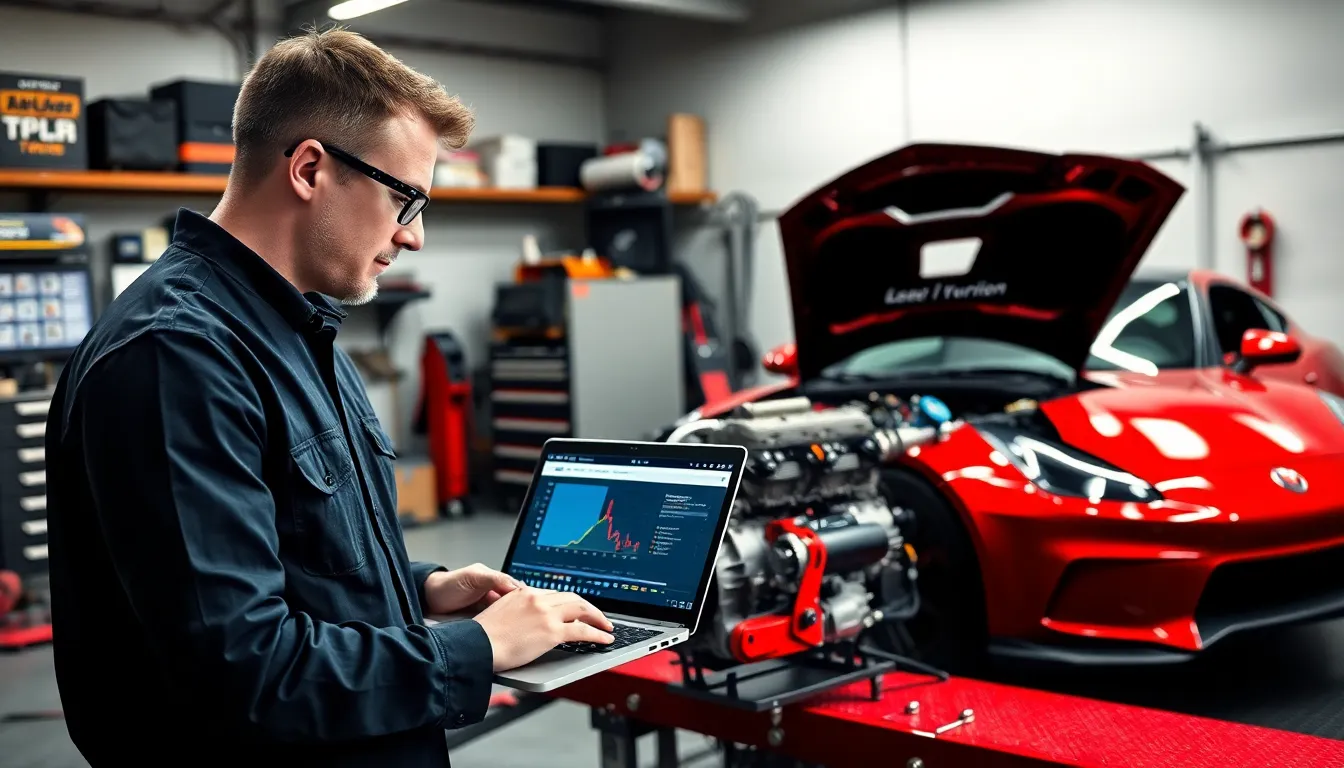
Professional tuning separates weekend hobbyists from dedicated enthusiasts who demand maximum performance from their builds. We’re diving into advanced methodologies that require precision, expertise, and specialized equipment to unlock your vehicle’s true potential.
Dyno Tuning and Data Logging
Dynamometer testing provides the foundation for professional engine optimization, measuring actual power output while allowing real-time adjustments to fuel maps and ignition timing. We recommend investing in dyno sessions at reputable facilities equipped with modern Dynojet or Mustang dynamometers, which offer accurate load simulation and environmental controls.
Professional tuners use data logging systems to monitor critical engine parameters including air-fuel ratios, exhaust gas temperatures, and knock detection during dyno runs. Companies like AEM and Haltech produce advanced engine management systems that record hundreds of data points per second, enabling precise calibration adjustments.
Wide-band oxygen sensors play a crucial role in achieving optimal air-fuel ratios across the entire RPM range, with brands like Innovate Motorsports and AEM offering reliable answers for continuous monitoring. Data analysis reveals power curves, torque delivery characteristics, and potential issues before they cause engine damage.
Multiple dyno pulls at different environmental conditions help establish consistent tune parameters, ensuring reliable performance regardless of weather variations. We’ve observed power gains ranging from 15-40% through proper dyno tuning compared to generic flash tunes, depending on the vehicle platform and modification level.
Professional shops typically charge $400-800 for comprehensive dyno tuning sessions, but the investment pays dividends through improved reliability and maximum power extraction from existing modifications.
Track-Focused Modifications
Race-oriented suspension setups prioritize handling precision over street comfort, utilizing adjustable dampers with separate compression and rebound controls for optimal track performance. Brands like Ohlins, KW, and AST offer professional-grade systems with remote reservoirs and multiple adjustment ranges.
Aerodynamic packages become essential at higher speeds, with front splitters, canards, and rear wings generating measurable downforce improvements. Companies like APR Performance and Seibon manufacture wind tunnel-tested components that provide genuine aerodynamic benefits rather than purely aesthetic enhancements.
Weight reduction programs target non-essential components through carbon fiber replacements, aluminum panels, and interior stripping to improve power-to-weight ratios. Removing sound deadening, rear seats, and replacing glass with polycarbonate windows can reduce vehicle weight by 200-500 pounds.
Roll cages and safety equipment become mandatory for serious track use, with custom-fabricated cages providing both chassis rigidity and driver protection. SCCA and NASA sanctioning bodies require exact cage specifications that professional fabricators must follow for competition eligibility.
Brake cooling systems prevent fade during extended track sessions, using ducting and backing plates to channel airflow over rotors and calipers. Companies like APR and Agency Power offer complete cooling kits designed for exact vehicle platforms.
Data acquisition systems like AiM Sports and Race Technology provide detailed telemetry analysis, recording lap times, G-forces, and vehicle dynamics for performance optimization between sessions.
Common Mistakes to Avoid When Building Tuned Cars
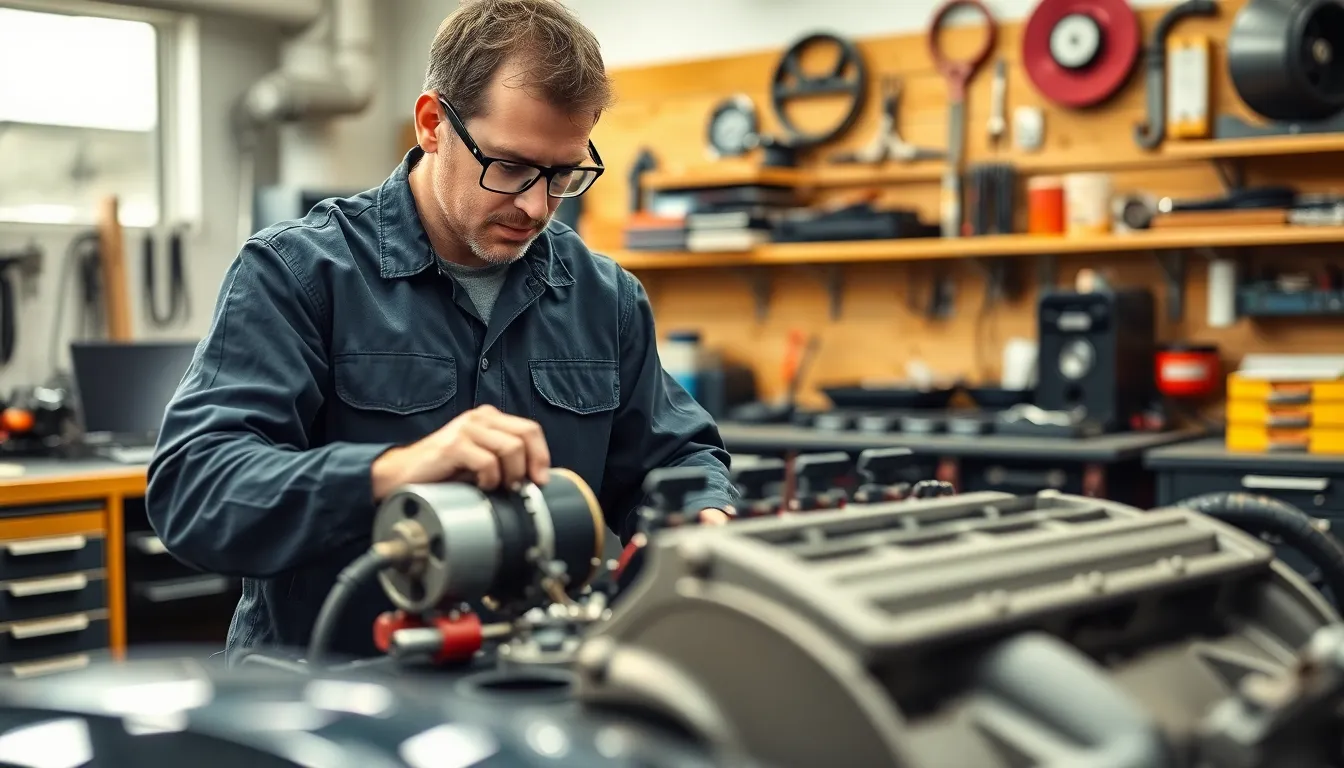
Building tuned cars becomes significantly more rewarding when we avoid common pitfalls that can drain budgets and compromise safety. We’ve identified the most frequent mistakes that enthusiasts encounter during their modification journeys, helping you navigate the complex industry of automotive tuning with confidence.
Skipping the Research Phase
Many enthusiasts rush into modifications without understanding their vehicle’s exact platform requirements. We recommend spending at least two weeks researching your car’s tuning potential before making any purchases. Forums dedicated to your exact model provide invaluable insights from experienced builders who’ve already navigated common challenges.
Compatibility issues arise when parts aren’t designed to work together harmoniously. We suggest creating a comprehensive modification list that considers how each component interacts with existing systems. Professional tuners often see projects fail because owners mixed incompatible brands or ignored prerequisite modifications.
Choosing Parts Based on Price Alone
Budget considerations matter, but selecting the cheapest available parts typically leads to disappointing results and additional expenses. We’ve witnessed countless builds where low quality components failed within months, forcing owners to purchase replacements. Quality aftermarket parts from established manufacturers like Cobb, AEM, and KW Suspension offer superior reliability and performance.
Installation costs compound when cheap parts require frequent replacement or cause damage to other components. We recommend allocating 60% of your budget to high quality core modifications and 40% to supporting upgrades. This approach ensures foundational components can handle increased performance demands without premature failure.
Ignoring Supporting Modifications
Engine modifications without corresponding fuel system upgrades create dangerous lean conditions that can destroy motors. We consistently see builders add turbochargers or increase boost pressure while retaining factory fuel injectors and pumps. These oversights result in catastrophic engine failure that costs thousands more than proper supporting modifications.
Suspension modifications require careful consideration of spring rates, damping settings, and alignment specifications. We recommend consulting with suspension specialists who understand your exact vehicle platform and intended use. Mismatched components create handling issues that compromise both performance and safety.
Attempting Complex Installations Without Proper Tools
Professional grade tools significantly impact installation quality and component longevity. We’ve observed many projects where improper torque specifications or inadequate equipment damaged expensive parts during installation. Investing in quality tools or hiring experienced technicians prevents costly mistakes and ensures modifications perform as intended.
Electrical modifications demand specialized knowledge of automotive wiring and control systems. We strongly advise against DIY ECU installations or custom wiring harnesses without proper training. Incorrect electrical work can damage expensive engine management systems or create safety hazards.
Overlooking Legal Compliance
Emissions regulations vary significantly between states, creating legal complications for modified vehicles. We recommend researching local laws before purchasing parts that might violate clean air standards. California’s CARB compliance requirements are particularly strict, and violations can result in hefty fines during vehicle inspections.
Street legal status becomes questionable when modifications exceed noise limits or alter safety equipment. We suggest maintaining documentation for all modifications and ensuring they comply with DOT regulations. Track only modifications should be clearly labeled and never used on public roads.
Rushing the Build Process
Quality modifications require patience and careful planning to achieve optimal results. We’ve seen rushed builds suffer from poor workmanship, incomplete installations, and inadequate testing. Professional shops typically allocate exact timeframes for each phase, allowing proper curing time for adhesives and sealants.
Testing phases help identify issues before they become expensive problems. We recommend break in periods for new components and gradual increases in performance levels. This methodical approach reveals potential problems while components are still under warranty.
Neglecting Insurance Considerations
Modified vehicles require specialized insurance coverage that protects both standard and aftermarket components. We advise documenting all modifications with receipts, photos, and professional installation certificates. Standard auto insurance policies often exclude coverage for aftermarket parts, leaving owners vulnerable to important financial losses.
Agreed value policies provide better protection for heavily modified vehicles than standard replacement cost coverage. We recommend working with insurers who specialize in modified vehicles and understand the true value of quality aftermarket components. These specialists can provide appropriate coverage limits that reflect your actual investment.
Conclusion
The industry of tuned cars offers endless possibilities for automotive enthusiasts who want to push their vehicles beyond factory limitations. We’ve explored everything from basic cold air intakes to advanced dyno tuning techniques that can transform any car into a personalized masterpiece.
Whether you’re drawn to the performance gains of turbo upgrades or the visual impact of custom body kits your journey into car tuning should always prioritize quality parts and professional installation. Remember that successful builds require patience proper planning and compliance with local regulations.
The tuning community continues to evolve with new technologies and techniques emerging regularly. By avoiding common mistakes and investing in reputable shops you’ll create a modified vehicle that reflects your passion while delivering the performance and style you’ve always envisioned.
Frequently Asked Questions
What are tuned cars and how do they differ from stock vehicles?
Tuned cars are vehicles modified beyond their factory specifications to enhance performance, aesthetics, or both. Unlike stock vehicles, tuned cars feature upgrades to engines, exhaust systems, suspension, ECU mapping, and visual elements like body kits or custom paint jobs. These modifications transform ordinary vehicles into personalized masterpieces that reflect the owner’s style and performance goals.
How much does it cost to start tuning a car?
Starting costs for car tuning vary widely depending on your goals and vehicle. Budget-friendly modifications like cold air intakes, performance filters, or lowering springs can cost $200-800 each. Basic ECU tuning ranges from $400-1,000. For beginners, expect to spend $1,000-3,000 for initial modifications, though you can start smaller with used parts and simple aesthetic upgrades.
What are the most popular cars for tuning?
Popular tuning platforms include Japanese icons like the Honda Civic Type R and Subaru WRX STI, European powerhouses such as BMW M3 and Volkswagen Golf GTI, and American muscle cars like Ford Mustang GT and Chevrolet Camaro SS. These vehicles offer excellent modification potential, strong aftermarket support, and proven performance gains through tuning.
Is tuning a car legal?
Car tuning legality depends on your location and specific modifications. Federal emissions standards prohibit removing emissions control equipment on street-driven vehicles. California has the strictest CARB compliance requirements. Many performance modifications are legal, but always check local and state regulations. Race-only vehicles may have exemptions from certain restrictions.
What should I look for when choosing a tuning shop?
When selecting a tuning shop, research their reputation and specialization in your vehicle platform. Look for professional certifications, review their portfolio of previous builds, and ensure they have modern equipment. Effective communication, clear project management, warranty policies, and transparent pricing are essential factors for a successful tuning experience.
What are the best beginner tuning modifications?
Ideal beginner modifications include cold air intake systems ($300-600), performance air filters ($50-150), ECU tuning ($400-800), lowering springs ($200-500), and cat-back exhaust systems ($500-1,200). These modifications provide noticeable performance improvements, are relatively simple to install, and don’t require extensive supporting modifications to maintain reliability.
How do I avoid common tuning mistakes?
Avoid common mistakes by thoroughly researching your vehicle platform before starting modifications. Create a comprehensive modification list to ensure part compatibility. Don’t choose parts based solely on price – quality matters for safety and performance. Plan supporting modifications, use proper tools, comply with legal regulations, and don’t rush the build process.
Do I need special insurance for a tuned car?
Yes, tuned cars often require special insurance considerations. Document all modifications and report them to your insurance company to maintain coverage. Standard insurers may not fully cover modified vehicles. Consider specialty insurers who understand tuned cars better. For track use, separate motorsports insurance is typically required for adequate protection.

